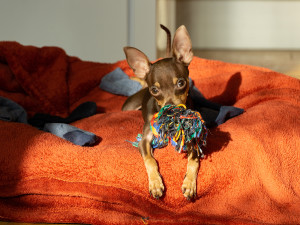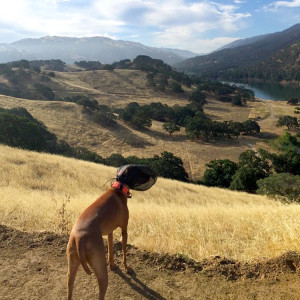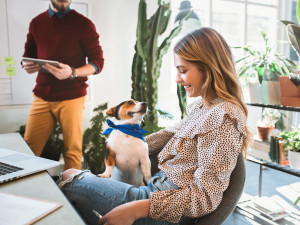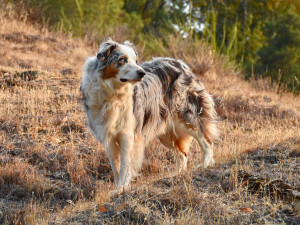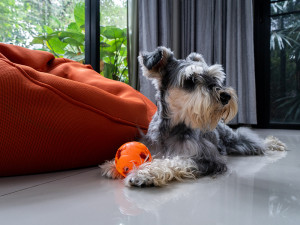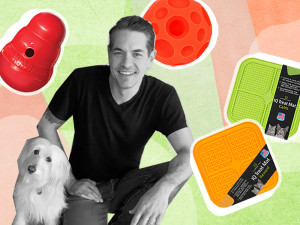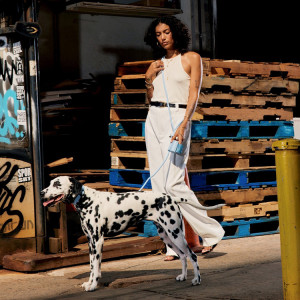7 Ways to Stop Your Dog from Scavenging on Walks
If your dog tries to scarf down literally everything in sight, you need this advice.
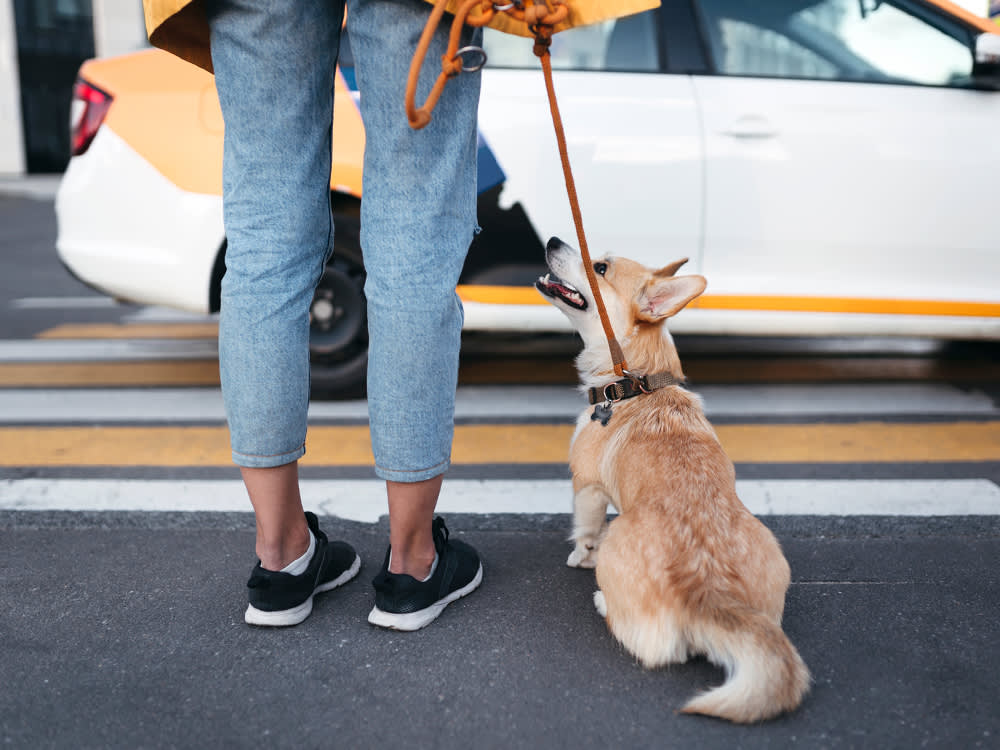
Share Article
Dogs are scavengers — there’s no pretending otherwise. And some dogs embrace their scavenger nature more than others. If your dog seeks out food (and even things that are most definitely not food) on walks and snarfs it down, you know how scary that can be.
If the item they swallow is toxic or causes an intestinal blockage, that can mean an expensive vet visit. But more importantly, snarfing down unknown items is dangerous, which is why it is essential to have some answers to the question, “How do I get my dog to stop eating everything?”
You can’t stop people from littering and you can’t control nature, so fast-food wrappers, chicken bones, toxic nuts, dead birds, rotting sticks, and barely-buried cat poo will always be around. What you can do is protect your dog from the dangers of gulping down the stuff they find.
If your dog is prone to scavenging, protecting them from trouble is a difficult but worthy challenge. Here are some ways to do it.

How To Stop A Dog From Eating Everything
1. Teach your dog such a good “leave it” that it works every time.
“Leave it” tells your dog that they’re not allowed to take a particular item — but you must “proof the cue” (aka, get your dog to respond to a cue in all situations) until they’ve mastered it. You’re probably thinking, “I’ve already tried to teach my dog to do this. It just doesn’t work a lot of the time, especially when they find something extra-special.” I do know how hard it is to successfully teach a dog they can’t have something that’s right under their nose just because you say so.
That’s where “proofing the cue” comes in. Teaching a dog to do something is one part of dog training, but most of the effort is about getting them to do it regardless of what else is going on — in other words, helping them succeed no matter how distracting the environment and how enticing the treasure. Working with a trainer will make it far more likely that you can successfully proof your dog’s “leave it” so you can use it when it really matters.
2. Reward your dog for paying attention.
When you’re out on walks, in the yard, or anywhere your dog may be distracted by things to eat, make it worth their while to check in with you. When your dog looks at you, give them something amazing, such as a chunk of real chicken, a small piece of steak, or a bone to chew. In a world filled with interesting things to smell and eat, you have to offer items good enough to compete.
If your dog learns that you have special treats that only appear when you are in the great outdoors, they’ll be more likely to pay attention to you. They will also be more likely to respond when you say their name or ask them to “watch.” When you can reliably ask for and get your dog’s attention, you can do so preventively when you see something that may tempt them, thereby avoiding the problem altogether.
3. Teach your dog how to trade.
Trading high-value items is an important skill for dogs who like to scavenge on walks. It is important to build up value to help your dog understand that giving up an item they found is more valuable to them than keeping it from you or eating it. Start with easy items, like your dog’s toys.
When your dog picks up a toy, you can play tug with them or fetch, when your dog comes towards you use a HIGH value treat (chicken, liver, low sodium hot dogs-the treats must be really good/stinky!) and put it up to their nose as their mouth opens say, “trade/drop it,” and immediately put that treat in their mouth once the toy is out.
As your dog gets better at this and has started to understand that “trade” means to drop it, you can begin to do the trade with higher demand items like a chew toy. If your dog shows any signs of resource guarding (growling, air snapping, tensing, turning away, or whale eye) you should enlist the help of a trainer before trying to train this behavior.
4. Walk in areas with fewer temptations.
Every place you walk your dogs may have objects that you don’t want them to inhale, but some spots are worse than others. Choose places that offer the fewest temptations in the way of trash and other dangers. Completely avoid areas that could have toxic items, such as hickory nuts or pecans. If your walks include little-traveled roads, one option is to walk in the roadway to avoid surprises hiding in hedges or on people’s lawns.
5. Make eating an adventure for the mind.
Dogs who inhale everything they come across often find searching for food and eating it to be the most exciting part of life. If you provide them with opportunities to indulge their drive to seek and consume, it helps take the edge off their desperate need to do so on walks. It won’t stop this behavior, but finding other outlets for it helps lessen the intensity, making it more likely that you can divert their attention with the techniques discussed above.
For example, feed your dog by scattering their kibble over a wide area. If you devote half of the kitchen to your dog’s dinner, they have to search for each piece, and that allows them to use their brain and nose at every meal. It also keeps them from eating their dinner in just a few seconds. You could also try making a snuffle mat, a homemade toy that lets dogs sniff out treats.
6. Do some nose work with your dog.
Teach them to use their nose in games. Two of the easiest are “Find It,” where you ask your dog to stay and then hide a treat (or treats) they have to find, and “Which Hand,” which allows them to choose the hand that holds a treat by nudging it gently. If they choose correctly, they receive the treat.
7. Slow down your dog’s eating with a special bowl designed for this purpose.
Many slow feed bowls have protrusions that dogs must work around to access their food. This slows them down and requires them to work harder to eat, which provides them with mental stimulation and the ability to make eating slowly a habit.
8. In extreme cases where health is at risk, consider using a muzzle.
Sometimes people stop walking their dogs because of the risk that their dog will snarf up something truly dangerous. While that’s better than a medical emergency, not walking your dog can compromise their quality of life. Another (potentially better) option is to physically prevent your dog from being able to ingest these dangers.
One barrier is a muzzle. Many people are reluctant to use one because they worry others will think their dog is aggressive, but I wish all the shame and embarrassment associated with muzzles would disappear from our world. Using a muzzle can improve the quality of your walks, allowing your dog to safely sniff and roll and play and enjoy themself.
It’s important that the muzzle doesn’t interfere with your dog’s ability to pant to cool themself off, so choose a basket muzzle rather than a cloth one. A mesh OutFox Field Guardopens in new tab — originally made for a protection against dangerous foxtail awns — can also keep dogs from ingesting rocks, worms, trash, and all the other temptations out there. It is a mesh covering for a dog’s entire head that does not interfere with panting, sniffing, playing, or drinking.
Dogs who love to snarf up things are certainly in danger of hurting themselves (and your budget). But dogs who inhale the world in a second often have a zest for life, and know how to make the most of it. So, while we may not want to follow their lead on what to consume, many of them set a great example of how to “suck out all the marrow of life,” as Thoreau so famously wrote.

Karen B. London, PhD, CAAB, CPDT-KA
Karen B. London is a certified applied animal behaviorist (CAAB) and certified professional dog trainer (CPDT) who specializes in working with dogs with serious behavioral issues, including aggression. She has written for a variety of magazines including The Bark, Clean Run, and the APDT Chronicle of the Dog, and has published in scientific journals including Behavioral Ecology and Sociobiology, Ethology, Ecology, and Evolution, the Journal of Insect Behavior, and Insectes Sociaux. She is the author of seven books about dog training and canine behavior, including the forthcoming My Dog's Mystery Adventure: And Other Stories From a Canine Behaviorist and Dog Trainer.
Related articles
![Woman at work with her small dog on her lap]()
8 Reasons to Take Your Dog to Work
June 25th is Take Your Dog to Work Day. From reducing stress to improving morale, here’s why pet-friendly offices are where it’s at.
![Australian Shepherd on a hill during golden hour]()
How to Hike Safely With Your Dog This Summer
Time to get your gear—and your pup—ready to go.
![Miniature Schnauzer dog playing with a ball at home]()
9 Fun and Educational Toys for Dogs
Behaviorist Karen London shares her list of must-have toys for dogs.
![dog trainer robert haussman, aka dogboy, shares his favorite dog training tools and toys]()
Dog Trainer Robert Haussmann’s Favorite Enrichment Toys
Kinship Collective expert shares his top toys and tools, from classics Kongs to snuffle mats to slow feeders.
![A stylish young woman wearing a white jumpsuit walking her Dalmatian dog with a light blue hands-free leash made by the Fable brand]()
8 Hands-Free Dog Leashes for Running (or Texting)
Remember to stay alert!

